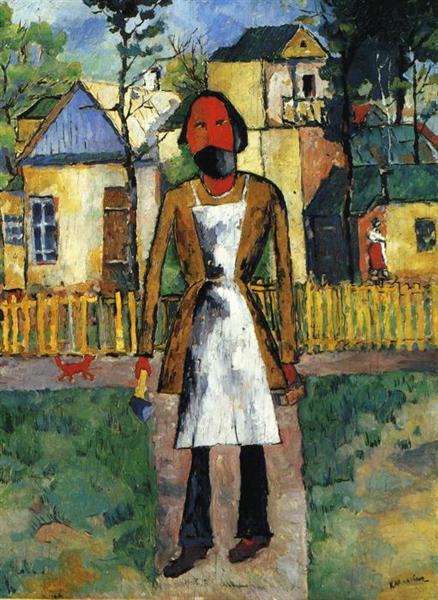Description
Kazimir Malevich, one of the most outstanding figures of modern art and pioneer of suprematism, left a legacy of works that remain study and admiration. Among these is his work "carpenter" of 1927. Painting not only reflects his artistic evolution, but also a crucial moment in his career, when his aesthetic concerns were intertwined with a renewed intention of connecting with more human and everyday themes.
In "Carpenter", Malevich portrays a human figure in the midst of its occupation, with almost monumental simplicity. The figure of the carpenter is represented in a geometric and stylized way, reminiscent of the forms that defined their suprematist stage, but with a clear transition towards the figurative. The carpenter, anonymous and without a defined face, is erected as a symbol of the common worker, a wink to daily life and the value of manual labor in a time of social and economic change in the Soviet Union.
The composition presents a balanced and clear structure, almost architectural, where geometric lines and shapes live in harmony. The use of color is moderate, predominantly terrible and ocher tones, which give the scene an atmosphere of sobriety and focus. This color palette contrasts with the living and often discordant colors of their previous supreme works, suggesting a turn towards a more accessible and tangible narrative.
Observing the details, the carpenter appears surrounded by its tools and materials, all represented with the same geometric austerity as its figure. This stylistic choice highlights Malevich's attempt to transcend the mere realistic representations and create a work that, although figurative, retains the principles of simplification and abstraction that were crucial in their artistic development.
The context in which this painting was created is crucial to fully understand. Malevich, after years of dedicating himself completely to abstractionism with suprematism, was in a kind of reconciliation with the visible and concrete world. This process of return to the figurative was parallel to his attempts to align with the official demands of art in the Soviet Union of the time, which promoted greater accessibility and connection with the proletariat.
For Malevich, "Carpenter" is not simply a portrait of a trade, but a declaration of artistic principles. It is the synthesis of your search for universal visual language, capable of talking about both the most abstract ideas and the most concrete realities. It is a testimony of its ability to evolve and adapt, without giving up its fundamental aesthetic convictions.
In summary, "Carpenter" by Kazimir Malevich is a work that encapsulates a crossroads in the artist's trajectory. It is a testimony of its ability to integrate the abstract with the concrete, and to talk about everyday life with a voice that remains unmistably yours. The painting remains a reference point to understand the amplitude and depth of the Malevich genius, revealing its continuous commitment to the exploration and renewal of artistic forms.
KUADROS ©, a famous paint on your wall.
Hand-made oil painting reproductions, with the quality of professional artists and the distinctive seal of KUADROS ©.
Art reproduction service with satisfaction guarantee. If you are not completely satisfied with the replica of your painting, we refund your money 100%.

